Table of Links
Abstract and I. Introduction
II. Overview of error Mitigation Methods
III. Methodology
IV. Results and Discussions, and References
III. METHODOLOGY
To understand how a blackbox model of error suppression and circuit optimization can be used to enhance the data loading process on NISQ hardware, we performed the inference based on our pretrained C-QGAN circuit on IBM Kyoto with and without Fire Opal. Before running these tests, we trained circuits using a quantum simulator to obtain optimal parameters and then tested on actual hardware. The results were then compared against the
outputs generated on Qiskit statevector simulator, which theoretically generates perfect results without noise. The performance of Fire Opal was then quantified by using the Kullback-Leibler (KL) divergence to quantify the difference between the the simulator results and the results on quantum hardware with and without Fire Opal.
Four distributions corresponding to different timesteps were loaded with controlled registers corresponding to respective time steps given in [1]; the circuit is displayed in Figure 1. Specifically, as shown in Fig. 1, the circuit is composed of generator registers (5 qubits) and controlled registers (2 qubits), whereby the generator anstaz is based on the Two-Local circuit in Qiskit. The Two-Local subprocess consists of two layers of Ry gates and a layer of one-to-all control-Z gates in-between the Ry layers. In our experiments, we fully entangled all the qubits. Further explanation of the algorithm and circuit structures can be found in [1]
We used two different circuits with increasing depths to understand the performance of Fire Opal with increasing number of two-qubit gates by increasing the depth of the ansatz layer in the generator. Specifically, two different circuit depths were tested. The moderate circuit depths contained a total number of gates at 120 (40 two-qubit gates), and much deeper circuit with 205 (50 two-qubit gates). In addition, the moderate circuit was sampled with 4096 shots, and the longer circuit was sampled with 8000 shots.
As our baseline, we ran the C-QGAN circuits on IBM Kyoto without error suppression techniques. In order for the quantum circuits to be executed on quantum hardware, the original circuits need to be transpiled to match IBM Kyoto’s topology, and its native gates. To maximize the performance, we aimed to reduced the total number of gates, especially the two-qubit gates to reduce the noise contribution. As a result, we used the highest level of optimization possible, which is level 3. This resulted in a total number of native gates of 784 for the moderate depth circuit, and 997 for the longer circuit. In addition, since this is the baseline experiments, we did not include any error mitigation so that we can quantitatively asses the performance of Fire Opal. When the circuits were ran with Fire Opal, the original circuits were used as input without transpilation since Fire Opal has a function for circuit optimization. To activate Fire Opal the function on IBM cloud, the settings were changed on the instance to “q ctrl”.
IV. RESULTS AND DISCUSSIONS
Analysis of testing results shows clear improvement in the Fire Opal distribution compared to IBM Kyoto by itself; see Figure 3 for a visual of the analysis. Fire Opal reduced noise and yielded better overall results on IBM Kyoto by around 30% − 40%. Specifically, the distributions generated on IBM Kyoto with Fire Opal qualitatively captures the specific shape of the distribution with peaks and the long tail. This becomes more pronounced as the number of two-qubit gates.
In conclusion, our experiment validates the effectiveness of Fire Opal’s error suppression and circuit optimization capabilities, highlighting potential to enhance the utilities of quantum hardware in the NISQ era.
[1] S. Certo, A. Pham, N. Robles, and A. Vlasic, Conditional generative models for learning stochastic processes, Quantum Machine Intelligence 5, 42 (2023).
[2] A. Montanaro, Quantum speedup of monte carlo methods, Proceedings of the Royal Society A: Mathematical, Physical and Engineering Sciences 471, 20150301 (2015).
[3] L. Grover and T. Rudolph, Creating superpositions that correspond to efficiently integrable probability distributions, arXiv preprint quant-ph/0208112 (2002).
[4] M. Mirza and S. Osindero, Conditional generative adversarial nets, arXiv preprint arXiv:1411.1784 (2014).
[5] S. Herbert, The problem with grover-rudolph state preparation for quantum monte-carlo, arXiv preprint arXiv:2101.02240 (2021).
[6] S. Bhattacharjee, S. Sarkar, K. Das, and B. Sarkar, Enhancing quantum variational algorithms with zero noise extrapolation via neural networks, arXiv preprint arXiv:2403.07025 (2024).
[7] Z. Cai, R. Babbush, S. C. Benjamin, S. Endo, W. J. Huggins, Y. Li, J. R. McClean, and T. E. O’Brien, Quantum error mitigation, Rev. Mod. Phys. 95, 045005 (2023).
[8] T. Giurgica-Tiron, Y. Hindy, R. LaRose, A. Mari, and W. J. Zeng, Digital zero noise extrapolation for quantum error mitigation, in 2020 IEEE International Conference on Quantum Computing and Engineering (QCE) (IEEE, 2020) pp. 306–316.
[9] A. Kandala, K. Temme, A. D. C´orcoles, A. Mezzacapo, J. M. Chow, and J. M. Gambetta, Error mitigation extends the computational reach of a noisy quantum processor, Nature 567, 491 (2019).
[10] R. Majumdar, P. Rivero, F. Metz, A. Hasan, and D. S. Wang, Best practices for quantum error mitigation with digital zero-noise extrapolation, in 2023 IEEE International Conference on Quantum Computing and Engineering (QCE), Vol. 1 (IEEE, 2023) pp. 881–887.
[11] E. Van Den Berg, Z. K. Minev, A. Kandala, and K. Temme, Probabilistic error cancellation with sparse pauli–lindblad models on noisy quantum processors, Nature Physics 19, 1116 (2023).
[12] Y. Ma and M. Kim, Limitations of probabilistic error cancellation for open dynamics beyond sampling overhead, Physical Review A 109, 012431 (2024).
[13] B. McDonough, A. Mari, N. Shammah, N. T. Stemen, M. Wahl, W. J. Zeng, and P. P. Orth, Automated quantum error mitigation based on probabilistic error reduction, in 2022 IEEE/ACM Third International Workshop on Quantum Computing Software (QCS) (IEEE, 2022) pp. 83–93.
[14] R. Takagi, S. Endo, S. Minagawa, and M. Gu, Fundamental limits of quantum error mitigation, npj Quantum Information 8, 114 (2022).
[15] A. Hashim, R. K. Naik, A. Morvan, J.-L. Ville, B. Mitchell, J. M. Kreikebaum, M. Davis, E. Smith, C. Iancu, K. P. O’Brien, et al., Randomized compiling for scalable quantum computing on a noisy superconducting quantum processor, arXiv preprint arXiv:2010.00215 (2020).
[16] S. Chen, Y. Liu, M. Otten, A. Seif, B. Fefferman, and L. Jiang, The learnability of pauli noise, Nature Communications 14, 52 (2023).
[17] Z. Cai, X. Xu, and S. C. Benjamin, Mitigating coherent noise using pauli conjugation, npj Quantum Information 6, 17 (2020).
[18] Z. Cai and S. C. Benjamin, Constructing smaller pauli twirling sets for arbitrary error channels, Scientific reports 9, 11281 (2019).
[19] J. P. Santos, B. Bar, and R. Uzdin, Pseudo twirling mitigation of coherent errors in non-clifford gates, arXiv eprints , arXiv (2024).
[20] C. Kim, K. D. Park, and J.-K. Rhee, Quantum error mitigation with artificial neural network, IEEE Access 8, 188853 (2020).
[21] M. R. Geller, Rigorous measurement error correction, Quantum Science and Technology 5, 03LT01 (2020).
[22] B. Nachman, M. Urbanek, W. A. de Jong, and C. W. Bauer, Unfolding quantum computer readout noise, npj Quantum Information 6, 84 (2020).
[23] A. M. Palmieri, E. Kovlakov, F. Bianchi, D. Yudin, S. Straupe, J. D. Biamonte, and S. Kulik, Experimental neural network enhanced quantum tomography, npj Quantum Information 6, 20 (2020).
[24] P. Czarnik, A. Arrasmith, P. J. Coles, and L. Cincio, Error mitigation with clifford quantum-circuit data, Quantum 5, 592 (2021).
[25] A. Lowe, M. H. Gordon, P. Czarnik, A. Arrasmith, P. J. Coles, and L. Cincio, Unified approach to data-driven quantum error mitigation, Physical Review Research 3, 033098 (2021).
[26] B. Pokharel, S. Srinivasan, G. Quiroz, and B. Boots, Scalable measurement error mitigation via iterative bayesian unfolding, Physical Review Research 6, 013187 (2024).
[27] H. Wang, Y. Xue, Y. Qu, X. Mu, and H. Ma, Multidimensional bose quantum error correction based on neural network decoder, npj Quantum Information 8, 134 (2022).
[28] D. F. Locher, L. Cardarelli, and M. M¨uller, Quantum error correction with quantum autoencoders, Quantum 7, 942 (2023).
[29] A. Chalkiadakis, M. Theocharakis, G. Barmparis, and G. Tsironis, Quantum neural networks for the discovery and implementation of quantum error-correcting codes, Chaos: An Interdisciplinary Journal of Nonlinear Science 33 (2023).
Authors:
(1) Anh Pham, Deloitte Consulting LLP;
(2) Andrew Vlasic, Deloitte Consulting LLP.
This paper is












